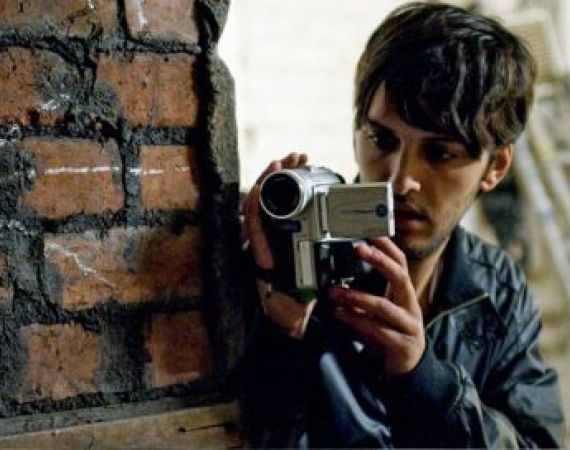Posted on Thu 10 Jul 2014
Kevin Moss: Telling secret social stories Lunchtime Talk write-up
Last Friday, Kevin Moss came to the Studio to talk about the art of telling stories across platforms as a pioneering form of theatre. He talked us through The Nightvision Experiment, a real time Twitter/YouTube horror story that he produced and co-created as part of PlayThisNext, and gave us an…

The Nightvision Experiment
Last Friday, Kevin Moss came to the Studio to talk about the art of telling stories across platforms as a pioneering form of theatre. He talked us through The Nightvision Experiment, a real time Twitter/YouTube horror story that he produced and co-created as part of PlayThisNext, and gave us an insight into what might be next.
At the beginning of his talk, Kevin outlined the difference between ‘making things digital’ and ‘making digital things’. People who use digital to its full advantage don’t take what already exists and shove it into a digital context. Instead, they build something new, which is designed to play to digital’s strengths. A question penned by Kim Plowright, and one that Kevin often asks himself, is ‘what is the affordance of digital?’ He said to get to the crux of the question, you have to also ask, what actually is digital? Regardless of what you think of; a website, an app, data, their common denominator lies in the ability to connect people. Similar to the combined experience of multi-player games, Kevin’s aim is to make multi-viewer stories, which only make sense when you sit virtually next to someone. Kevin unravelled this idea by telling us about his recent project, The Nightvision Experiment, a horror story told via social media, which has been described as ‘theatre for the Facebook generation.’
In order to participate in The Nightvision Experiment, participants bought tickets, and then were told to arrive at a character’s twitter page at 9pm. The live story branched out from that first twitter feed, and as unsettling videos began to emerge, so too did frantic conversations among friends and links to websites, gradually exposing the story. After this frenzied activity built into its terrifying finale, all of the footage was taken down.
There was more footage than people had time to watch before it disappeared, so different participants had slightly different knowledge of what actually happened, creating a good ‘froth’ (a Larping term for excited post-event discussions). People were using multiple devices to scour the constant stream of content being uploaded to the twitter list, so that they could have an uninterrupted view of the twitter stream, as well as watching footage, visiting websites and investigating other characters.
A few participants of the experience took it upon themselves to actively involve themselves in the story. One participant became a geneticist with a scientific insight into the strange occurrences taking place in the narrative. When he began interacting with other characters, PlayThisNext quickly wrote him into the narrative. Kevin told us that he and the team were expecting a certain level of active engagement, but were also aware that the majority of the participants would be lurkers. Kevin is fascinated by lurkers; he told us that put roughly, 1% of people on forums are heavy contributors, 9% are intermittent contributors, and 90% are lurkers. He made the observation that a lot of people who make the jump to digital storytelling want or expect everyone to actively interact with the narrative the create, and they often fall at the first hurdle, because they forget about this silent majority. Contrary to this, The Nightvision Experiment deliberately plays to people's sense of voyeurism.
Kevin feels that an integral part of the development of digital storytelling lies in learning to trust your audience. He called upon the example of the pioneering 1903 silent movie, The Great Train Robbery. Porter, the director, used certain editing techniques that had never been used publicly before. Some of the people involved in the making of the film were worried that their audience wouldn’t be able to comprehend ‘crosscutting’ (the editing technique of jumping from one scene or angle to another, describing multiple actions that are happening at the same time). The act of crosscutting exploded film open for others to explore it as an artform, and it is second nature to us today. Kevin admitted that it is tempting to try tell people stories in the simplest way possible, but in order to make The Nightvision Experiment, he and the team had to trust that their audience would understand twitter well, and be perfectly capable of navigating their way through the content. Kevin made the point that our current use of the internet is where our use of film was around the time of The Great Train Robbery; we are only half way through the process of finding out how we can get the best out of it.
Some of the feedback that Kevin and the PlayThisNext team received following The Nightvision Experiment suggests that people would like this kind of experience to be embodied in an app, so that they can navigate all of the content in one window. Kevin and the team are currently developing this idea for further real time story experiences, and are founding Tell, a business centred around the development of tools enabling others to create their own cross platform, real time storytelling apps.
If you want to be part of The Nightvision Experiment, look out for future performances here.